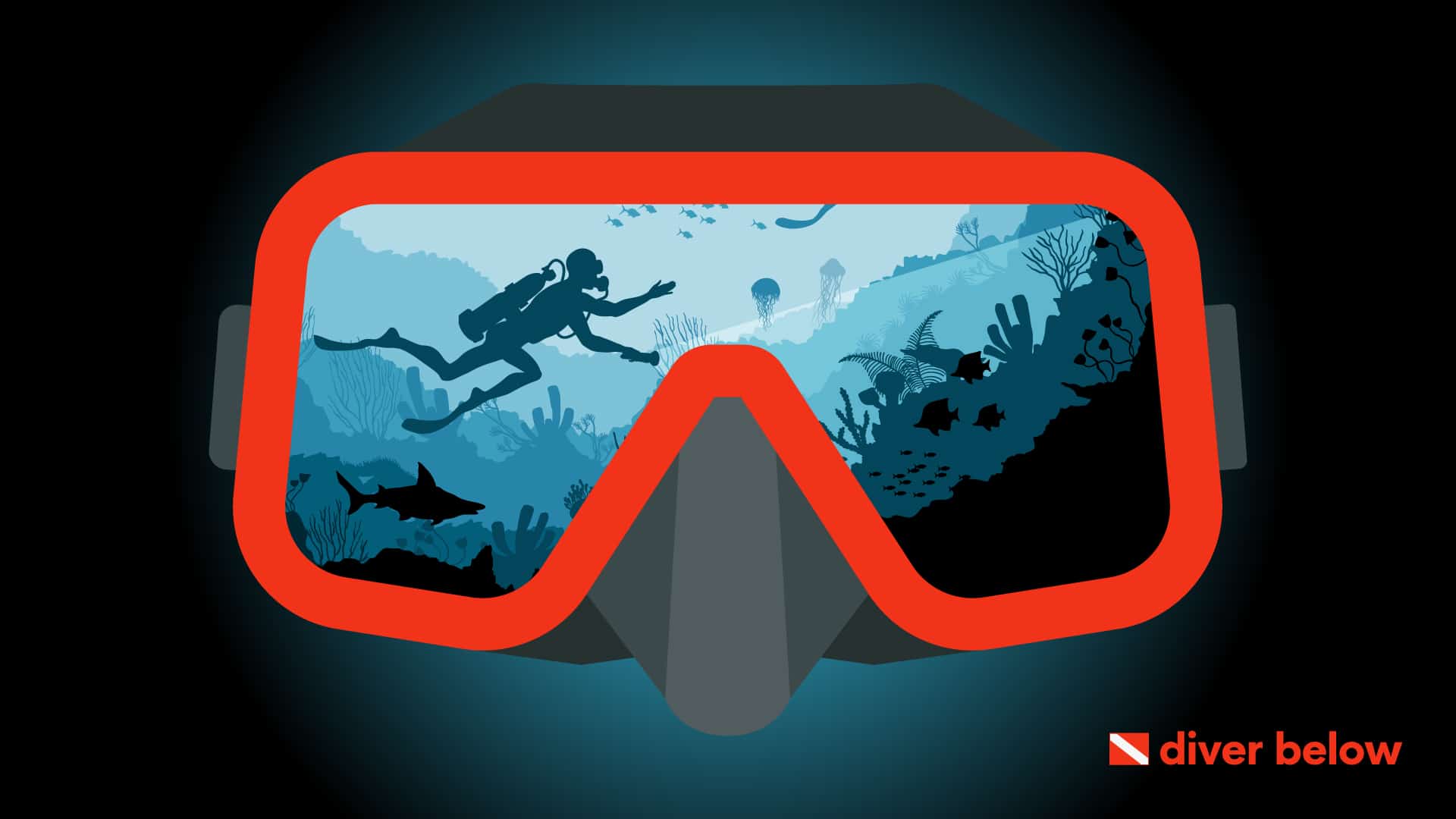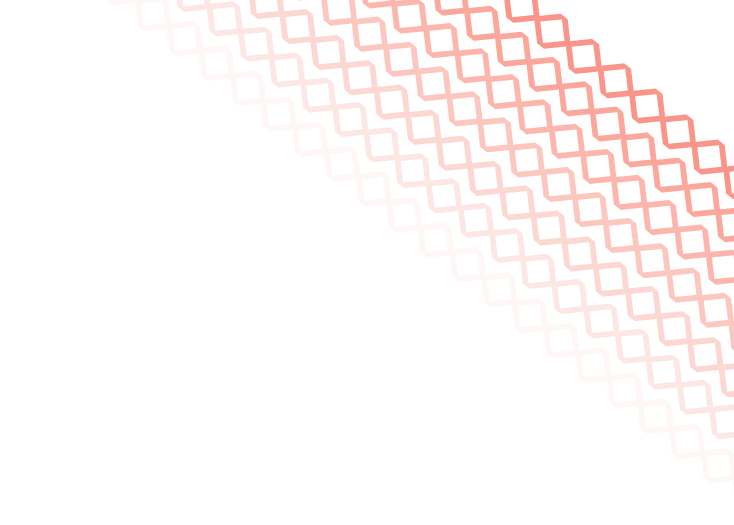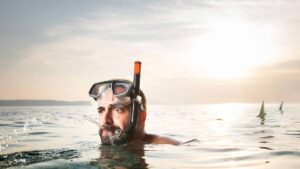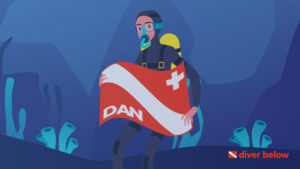A scuba mask is a vital piece of scuba gear for any underwater dive and exploration.
However, it is sometimes overwhelming when choosing the best scuba mask for you.
That’s why we dived deep (get it?) into this topic.
Keep reading to learn all about scuba masks and how to choose the best one for you.
Contents
What Is a Scuba Mask?
A scuba mask, also known as a dive mask, is essential equipment when diving underwater.
Humans cannot see well underwater, especially in salt water, where the salt stings our eyes.
Scuba masks allow our eyes to focus and be able to see underwater.
Historically, humans recorded the use of diving masks since the 1300s, when the Persians developed the first goggles using tortoise shells.
When self-contained underwater breathing apparatus (SCUBA) diving became popular in the early 1900s, the scuba mask as we know it was born.
[su_pullquote]Did you know? A scuba mask and snorkel mask seem like the same thing, but are very different. Snorkeling masks are made for shallow depths and are usually not built do withstand the pressures of diving below the water’s surface.[/su_pullquote]
How Do Scuba Masks Work?
Scuba masks work by creating a seal around the diver’s eyes and nose, leaving a small pocket of air between the eyes and water.
Masks have a design that allows them to be able to sustain this air pocket through pressure underwater.
This pocket of air is necessary for the diver to see and focus under the water.
In addition to helping you see underwater, scuba masks also assist with equalization while ascending and descending in depth.
Components to a Scuba Mask
There are four critical components to each scuba mask and one optional feature.
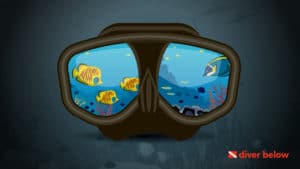
1. Lens
The lens of a scuba mask is the clear front area that you look through when diving.
Most of the time, these consist of standard tempered glass.
The lens must be sturdy enough to not crack under pressure while underwater, and tempered glass is resistant to cracks.
Cheaper masks may have lenses made from untreated glass or polycarbonate plastic, both of which are prone to scratching and cracks and aren’t suitable for diving.
Fun fact: if you wear contacts or glasses, you can even have prescription lenses made for use in your scuba or snorkeling masks.
2. Frame
The frame of a scuba mask holds the lenses in place.
Some newer style masks are frameless, where the lens molds into the skirt.
Frameless masks can fold flat, making them easier to store and carry.
Originally, scuba mask frames were made of rubber, but silicone is now the material of choice.
To frame or not to frame is all up to personal preference!
3. Skirt
The skirt of a scuba mask is one of the essential components, as this is what forms a seal against your face, creating that air pocket for your eyes.
Skirts made of high-grade silicone are considered the best quality.
Not only does silicone create a better seal that is comfortable against your face, but a silicone skirt is also very hardy and holds up well against UV damage and saltwater exposure.
A soft silicone skirt has a great feel to it and is even hypoallergenic!
4. Strap
The strap of a scuba mask holds the mask against your head.
They are often made of silicone or a material similar to the mask’s skirt.
Buckles can be found on the mask straps, attached to the mask’s frame, or even built into the skirt.
The buckle designs on your mask will vary based on brand and material.
5. Purge Valve
Once a standard component of scuba masks, the purge valve is not as popular nowadays.
Located on the nose pocket of a scuba mask, a purge valve sits to help clear water from inside the mask.
It is more popular now to see a small nose flap instead of a purge valve.
This nose flap opens when you exhale through your nose, allowing you to expel water that may have collected inside the mask.
Scuba Masks vs. Swimming Goggles
There are a few distinct differences between scuba masks and swimming goggles.
The main differences are in use and fit.
Scuba masks are explicitly used for scuba diving, freediving, or snorkeling, whereas swimming goggles are for swimming.
Sports like skiing, flying, skydiving, parachuting, etc., also recommend using goggles to protect people’s eyes.
Swimming goggles create a seal outside of the eyes only, and they often create individual air pockets for each eye.
Scuba masks, on the other fin, encompass the diver’s eyes and nose.
As described above in how scuba masks work, scuba masks not only provide air pockets so that you can see underwater but also help with equalization when diving.
Thus, swimmers can use scuba masks while swimming, but since swimming goggles don’t have this feature, divers cannot use goggles while diving.
Types of Scuba Masks
There are many scuba masks to choose from, perfect for both salt water and fresh water diving.
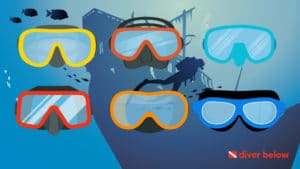
Popular types include:
- Twin-lens: Twin-lens masks use two separate viewing panes for your eyes.
- Single-lens: Single-lens masks use one viewing pane for both eyes. This single-lens design is preferred by people who do not wish to have anything blocking the center of their mask.
- Side pane: Side pane masks have front lenses and have extra glass side windows on either side, allowing you to use your peripheral vision when diving. This more expansive field of vision eliminates the “blinder” effect of traditional scuba masks.
- Angled lenses: Angled lenses are also great for better peripheral vision, as the side pane masks. Their expansive field of view is excellent for taking notes underwater or when walking aboard a boat as they allow for better downward vision.
In addition to mask type, there is also a wide range of colors and materials to choose from.
Some divers enjoy matching their masks with their dive gear and wetsuits.
Some divers prefer neoprene strap backs over silicone straps; they provide more comfort and don’t tangle with long hair.
In addition to various lens styles, another popular type of mask is a low-volume dive mask.
These are common among people who are into freediving but can also be used by scuba divers.
These masks sit closer to your face, which minimizes the amount of air inside your mask.
This low-volume design allows for easy cleaning of your mask.
How to Buy a Scuba Mask
Like with shoes, you should try on scuba masks before committing to one.
The proper fit is essential for a flawless and safe dive experience.
Professional dive shops are the best places to buy scuba masks, but if you know you like a particular brand, you can also try buying from name-brand shops or websites.
You can also look at everyday sporting goods stores, but they may not have the best quality masks available.
Overall, when choosing a scuba mask, you should look for one with a comfortable fit, a style you like, providing the best seal on your face.
Suggested Resource
Best Scuba Masks: a hand-curated list of the best scuba masks for divers
Frequently Asked Questions
Frequently asked questions about scuba masks include the following.

Can you use a scuba mask with a mustache?
Yes, you can use a scuba mask with a mustache.
Just make sure that your facial hair fits the shape of your mask so that the mask will seal adequately over your face.
If you need extra protection, you can apply a food-grade silicone to the rim of your mask to provide a better seal.
Are full-face scuba masks dangerous?
If poorly designed and misused, full face masks are dangerous because of the potential for CO2 poisoning.
Because they cover your entire face, and if there isn’t a proper way for air to escape from the mask, CO2 can build up inside your mask as you breathe.
They should not be used for underwater diving but are okay to use for floating.
A good rule of thumb is not to use them and stick to a proper scuba mask.
If you are looking to purchase one though, we recommend you splurge a bit and buy one of the best full-face snorkel masks, as they are usually safer than the lower-quality discount versions.
Can you use a scuba mask for snorkeling?
Yes, you can use a scuba mask for snorkeling, but it is not recommended to use snorkel masks for scuba diving.
Snorkel masks aren’t made to withstand the pressure of diving.
Can you put on a scuba mask underwater?
You can absolutely put on a scuba mask underwater.
In fact, it is an essential skill every diver should learn.
What happens if a scuba mask cracks underwater?
If a scuba mask cracks underwater, it will most likely leak and potentially flood with water.
The odds of a scuba mask snapping underwater, especially high-quality ones, is rare.
Why do divers spit in their masks?
Divers use spit to help defog their scuba masks.
Wrapping Up
There are many different styles and types of scuba masks available on the market.
It can be challenging to distinguish between a scuba mask and goggles and how to choose the best scuba mask for you.
However, this guide should help you on your scuba mask shopping journey.
Hopefully, we will see you in the water soon!
